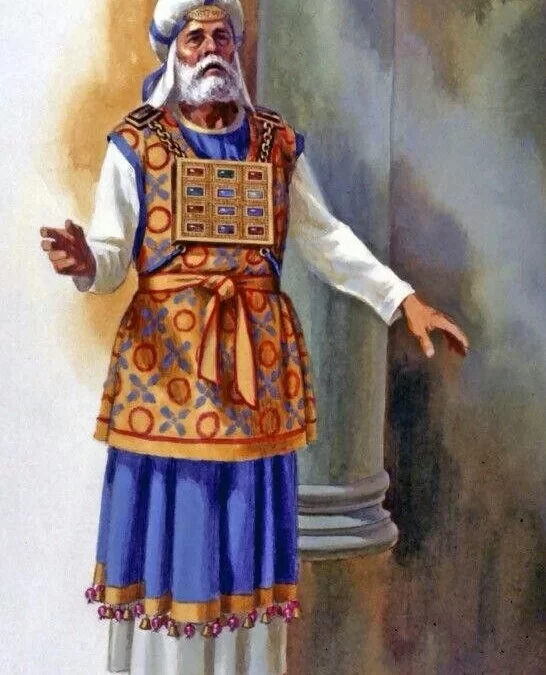by Rusty Guin
Throughout the Bible priests are mentioned over 780 times. The first priest mentioned was Melchizedek in Genesis 14:18, the priest of the most high God, El Elyon in Hebrew. The Levitical priesthood was established by God in the nation of Israel. There are different orders, types and duties of priests within the Levitical priesthood of the Bible. Among the priests of Israel there was a high priest that was anointed to serve in a unique fashion, such as entering the Holy of Holies once a year on the Day of Atonement. God’s establishing the office of priest ultimately finds its purpose and fulfilment in the Messiah of Israel, Jesus.
The Aaronic – Levitical Priest
The Aaronic Priesthood (also called the Levitical Priesthood) began with Aaron, the older brother of Moses, Exodus 28:1–3. The Aaronic priesthood ministered in the Tabernacle and later in the Temple. The Levitical priest (the term Levitical is derived from the tribe of Levi) had the responsibility of offering the sacrifices required by the Mosaic law, Deuteronomy 33:8-11. All priests were Levites, but not all Levites were priests. Most of the Levites just assisted the priests. One place the distinction is seen is in 1 Chronicles 23:2, “And he gathered together all the princes of Israel, with the priests and the Levites.” The primary word for “priest” in the Old Covenant is the Hebrew word כהן, “kohen.”
The Levitical priesthood was divided into three groups: 1) the high priest, 2) ordinary priests, and 3) the Levites. The Levites cared for the service of the sanctuary. The sons of Aaron, set apart for the special office of priest, could minister sacrifices at the altar. The highest level of priest, the high priest, represented bodily the height of the purity of the priesthood. He bore the names of all the tribes of Israel on his breastplate into the sanctuary, thus representing all the people before God, Exodus 28:29.
The priest acted as a mediator, the one who represented man to God. The Levites that were not priests were given various duties in the tabernacle and its furnishings, Numbers 3:21-26. They also served as judges and teachers of God’s law. The high priest was the only one allowed to enter into the Most Holy Place (Holy of Holies), 1 Chronicles 6:49, where was the presence of God. The high priest could enter the Most Holy Place one day a year, on the Day of Atonement, Yom Kippur, to offer a blood sacrifice for all the people, including himself, Leviticus 16. He was making a payment for sin, which restores the people’s relationship with God. In Hebrews 5:1 we are told, “For every high priest taken from among men is ordained for men in things pertaining to God, that he may offer both gifts and sacrifices for sins.” The high-priest was the mediator between God and the nation of Israel. He is one who represents and acts as an ambassador on behalf of the people.
The Levites had various duties in the Tabernacle/Temple and were divided into three groups: Gershonites (descended from Gershon) who took care of the tapestry of the tabernacle, such as curtains, hangings and ropes of the sanctuary, Numbers 3:25-26. The Kohathites (from Kohath) were responsible for “…the ark, and the table, and the candlestick, and the altars, and the vessels of the sanctuary wherewith they minister, and the hanging, and all the service thereof,” Numbers 3:31. The Merarites (from Merari) cared for the framework – posts, crossbars, courtyard, tent pegs, etc. of the sanctuary, Numbers 4:29-33. The Levites cared for the service of the sanctuary.
Originally, it was the firstborn son of every family who was consecrated to God for service, Exodus 13:1-2; and then, when God made Israel into a nation, He chose the tribe of Levi to serve Him, Numbers 3:12. The first born male children, who were not a Levite, were released from service through the concept of pidyon haben, or redemption of the first born. The father redeemed his wife’s first born son by offering to Aaron and his sons the equivalent of five silver shekels, Numbers 18:15-16. These are the type of coins/shekels used today for redeeming back the first born son.
Melchizedek: Priest of the Most High God
Melchizedek is first mentioned in Genesis 14:18-20 where he brings out bread and wine to Abram and his weary men, demonstrating friendship. He blessed him in the name of El Elyon and praised God for giving Abram a victory in the battle. Melchizedek was king of Salem (Jerusalem) as well as the priest of El Elyon, the most-high God. Melchizedek’s name in Hebrew means “king of righteousness.” There are two additional references of Melchizedek in the Bible. The first is Psalm 110:4 and the second is found in Hebrews 5:6-11 and chapter 7.
What we do know about Melchizedek the Priest-King?
- He was the first to hold the title of both priest and king, Genesis 14:18, Hebrews 7:1.
- His name means King of Righteousness, Hebrews 7:2.
- He was the king of Salem, Genesis 14:18, Hebrews 7:2.
- He was priest of the most-high God, El Elyon, Hebrews 6:20, 7:1-20.
- He has no record of his father, mother, or genealogy, Hebrews 7:3.
- He has no record of his beginning or end, Hebrews 7:3.
- He has an eternal priesthood, Hebrews 7:3.
Melchizedek is a picture of the Son of God. Hebrews 7 presents Jesus as being of the Melchizedekian priesthood. The question is whether the author of Hebrews is using Melchizedek literally or figuratively of Jesus. If literal, it indeed could be properly applied to the Lord Jesus Christ. No earthly king remains a priest forever and no human is without father or mother. If Genesis 14 describes a theophany, then God, the Son, appearing as the King of Righteousness and Peace came to Abraham and blessed him as the mediator between God and man, 1 Timothy 2:5. If the description of Melchizedek is figurative, then the description of having no genealogy, no beginning or ending, and a ceaseless ministry are simply statements about the mysterious nature of the person who met Abraham. In this case, not mentioning these details is purposeful and better serves to link Melchizedek with Christ.
The Messiah is said to be “a priest for ever after the order of Melchizedek,” in Psalm 110:4. In Hebrews, where both Melchizedek and Christ are considered kings of righteousness and peace, if the Scriptures portray Melchizedek and his unique priesthood as a type, the writer shows that Christ’s new priesthood is superior to the old Levitical order and priesthood of Aaron, Hebrews 7:1-10.
The Melchizedek priesthood was to belong to Christ, and to none other, forever. The writer of Hebrews concerning Jesus said: “But this man, because he continueth ever, hath an unchangeable priesthood,” Hebrews 7:24. The Greek word for unchangeable, ἀπαράβατον, ap-ar-ab’-at-os, means “untransferable; can’t be passed to another.”
Jesus: A “priest after the order of Melchizedek”
Are Melchizedek and Jesus the same person? A case can be made either way. At the very least, Melchizedek is a type of Christ, prefiguring the Lord’s ministry. But it is also possible that Abram, after his weary battle, met and gave honor to the Lord Jesus Himself.
One important point about Jesus’ priesthood — every priest is appointed from among men. Jesus, though God from eternity, became a man in order to suffer death and serve as our High Priest, Hebrews 2:9. As a man, He was subject to all the weaknesses and temptations that we are, so that He could personally relate to us in our struggles, Hebrews 4:15. Jesus is greater than any other priest, so He is called our “great high priest” in Hebrews 4:14, and that gives us the boldness to come “unto the throne of grace, that we may obtain mercy, and find grace to help in time of need,” Hebrews 4:16.
The significance of Jesus is that He did what others could not do, Hebrew 5:5-10. Jesus is everything that Melchizedek was, but is greater in every aspect you and I can possibly think or imagine with the human mind in the dimension in which we live. A priest forever because He offered himself a sacrifice for all on the cross. He was the perfect priest, who became our great high priest who was inaugurated to become the sinless lamb of God.
The Old Testament Levitical system of priests served to foreshadow the ministry of Jesus. The Levitical priesthood of Aaron’s line was not intended to continue forever. Jesus’ priesthood is eternal. Though not obvious to Abram at the time, the mysterious priesthood of Melchizedek pointed forward to the eternal priesthood of Jesus Christ, who ministers grace and mercy to us based on His own sacrifice for our sins. Jesus’ priesthood models that “after the order of Melchizedek.” He fulfills the office of priest, reconciling man to God, 2 Corinthians 5:19. Atonement under the Mosaic Law was temporary as it was man’s actions to attain forgiveness, Hebrews 10:1-4. Reconciliation viewed in the New Testament was permanent as it is God’s actions toward man.
“The LXX (Septuagint) translates kaphar (atonement) with exilaskomai…which means to make atonement…Kittel’s Theological Dictionary says that ‘The most striking thing about the development of the terms (exilaskomai and hilaskomai), however, is that words which were originally used to denote man’s action in relation to God cease to be used in this way in the NT and are used instead of God’s action in relation to man.’”1
“Katallasso [reconciliation] refers to the exchange of hostility or enmity to a friendly relationship. The basic idea of reconciliation is the restoration of friendly relationships after a period of enmity or estrangement. Thus katallasso means to change a person for the purpose of being able to have fellowship together. As discussed, Scripture always portrays God as the Reconciler and sinners as the ones reconciled, since it was human sin that ruptured the relationship between God and man.”2
Jesus: Our High Priest
Jesus is greater than the Law. He is greater than Moses. He is greater than the Levitical priesthood. He is greater than all the prophets. He is greater than Melchizedek. Jesus, our great high-priest, did what others could not do. No detail is too small in Scripture, and Melchizedek proves this. As an archetype of Jesus, he points us to a greater priesthood that will last eternally. Like the Levitical priests and the high priest, Melchizedek acts as a mediator between the people and God. And we later see this same role played out in the New Testament in a different way through Jesus.
Jesus, who hails from the order of Melchizedek, occupies the ultimate high priestly role and atones for our sins, allowing people to come face to face with God. Jesus was the needed priest who did not come from the line of Aaron, but instead a priest after the order of Melchizedek, the mysterious priest-king of ancient Jerusalem. His eternal priesthood introduces “a better hope through which we approach God,” since “he always lives to make intercession” for those who draw near to God through him, Hebrews 7:19, 25.
End Notes
1 https://www.preceptaustin.org/leviticus_17_commentary
2 https://www.preceptaustin.org/2corinthians_518-19_commentary

